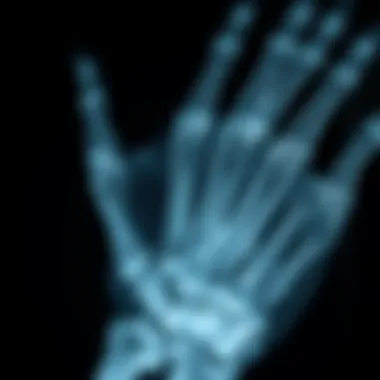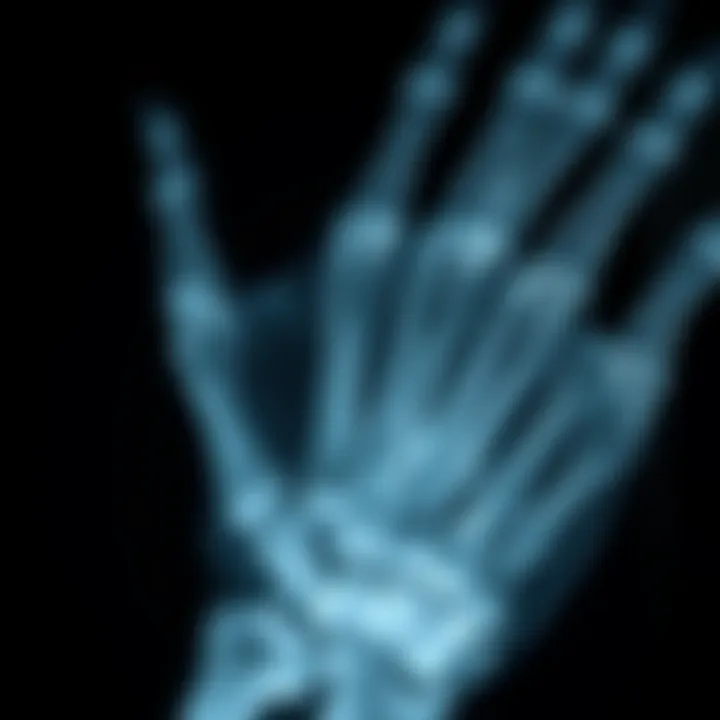Exploring Hand X-rays: Importance and Insights


Intro
Hand X-rays serve as a fundamental tool in medical diagnostics, pivotal for assessing various conditions affecting the hand and wrist. Understanding the nuances of hand X-rays can significantly impact the speed and accuracy of diagnosis, treatment planning, and patient outcomes. With advancements in technology and imaging techniques, the landscape of radiology has evolved remarkably, prompting a need for continued education and adaptation among medical professionals.
This article endeavors to demystify hand X-rays, examining their essential role within diagnostic medicine. We’ll explore not just the technical aspects of imaging, but also the anatomical considerations critical for accurate interpretation. Through detailed analysis, we’ll present common conditions that clinicians encounter in hand imaging and address the implications tied to the findings detected in X-rays. Students, researchers, and healthcare providers will find this exploration beneficial as they navigate the complexities of diagnosis through radiological imaging.
In essence, we aim to bridge the gap between technical jargon and practical application, making it accessible to a broad audience interested in enhancing their understanding of hand X-rays.
Prologue to Hand X-rays
When it comes to intricate structures like the human hand, understanding the nuances of X-ray imaging is absolutely vital. Hand X-rays serve a dual purpose in both diagnostics and treatment. They are not just simple images; they reveal crucial information about bone integrity, joint health, and soft tissue conditions. In this section, we will dissect the significance of hand X-rays and set the groundwork for the discussion ahead.
Definition and Purpose
At its core, a hand X-ray is a type of radiographic image specifically designed to capture the bones and soft tissues of the hand. The primary purpose of these images is to assist healthcare professionals in diagnosing various conditions, such as fractures, infections, and inflammatory diseases. Unlike mere photographs, hand X-rays provide a detailed look into not only the bony anatomy but also the spacing and condition of joints and surrounding tissues.
This imaging technique enables physicians to detect anomalies that may not be visible during a physical examination. For instance, a subtle hairline fracture might escape notice, yet a high-quality X-ray can reveal its presence, guiding treatment plans effectively. The ability to assess the hand's structure aids in formulating a precise diagnosis and subsequently determining the management plan.
"X-rays are remarkable tools in the diagnostic toolbox, allowing healthcare providers to visualize conditions from the inside out."
Historical Context
The journey of hand X-ray imaging is rooted in the history of radiology itself. The first X-ray was produced in 1895 by Wilhelm Conrad Roentgen, marking a revolutionary breakthrough in medical imaging. Soon after, practitioners began utilizing this technology for various applications, including the examination of limb injuries. By the early 20th century, hand X-rays gained prominence in clinical settings as they proved invaluable in identifying fractures and infections. As techniques evolved, the precision of these images improved, enhancing diagnostic accuracy.
In the decades that followed, improvements in film technology and the advent of digital radiography transformed the field. The transition from traditional film to digital X-rays increased image quality and significantly reduced radiation exposure for patients. Consequently, this progression laid the groundwork for more advanced imaging techniques and paved the way for enhanced patient care.
Understanding the historical context surrounding hand X-rays provides invaluable insight into the advancements we often take for granted today. As healthcare continues to evolve, the interplay of technology and patient care remains paramount, ensuring that hand X-rays will continue to be a cornerstone in diagnostic imaging.
Anatomy of the Hand
Understanding the anatomy of the hand is fundamental for interpreting hand X-rays effectively. The hand is a complex structure, housing numerous bones, joints, and soft tissues that work in concert to facilitate a wide range of movements. Each part of the hand has its unique function, contributing to the overall dexterity and utility of this vital body part. This section will delve deeper into the intricacies of bone structure and soft tissue considerations, guiding the reader toward a comprehensive understanding of the anatomical features most relevant in radiologic assessments.
Bone Structure
The skeleton of the hand comprises 27 distinct bones, which are categorized into three main groups: carpal bones, metacarpal bones, and phalanges. Each of these groups serves specific functions:
- Carpal Bones: There are eight carpal bones, arranged in two rows, which form the wrist joint. These bones enable the flexibility and intricate motion of the wrist, crucial for grasping and manipulating objects.
- Metacarpal Bones: The five metacarpals connect the wrist to the fingers and serve as the structural foundation of the hand. They play a significant role in supporting the palm's weight and providing stability for finger movements.
- Phalanges: Each finger has three phalanges (the thumb has two), which allow for the fine motor skills necessary for grasping and holding. Understanding the positioning and integrity of these bones is critical in diagnosing fractures or deformities.
"Anatomically, the hand is like an intricate puzzle. Each bone plays its part in allowing our hands to perform magic with movement."
In an X-ray image, radiologists look for various signs in the bone structure, such as alignment, density, and the presence of any fractures. Anomalies in these characteristics can suggest underlying conditions, whether they're acute injuries or chronic diseases like arthritis. Additionally, the positioning of the hand during the X-ray process can significantly affect the visibility of these bones. Proper alignment is essential for clear imaging results, assisting in accurate diagnosis.
Soft Tissue Considerations
While bone structure is vital in hand X-rays, soft tissues—tendons, ligaments, muscles, and nerves—also deserve careful attention. The soft tissue matrix supports the hand’s mobility and controls its movements.
- Tendons: These structures connect muscles to bones and are pivotal in hand function. When evaluating hand X-rays, radiologists must consider the integrity of these tendons, especially in cases of injury or conditions such as tendonitis.
- Ligaments: Stabilizing the skeletal structures, ligaments hold bones together at the joints. Injuries or tears in these ligaments can lead to joint instability, which may not be visible on a traditional X-ray but is critical to assess through comprehensive imaging.
- Nerves: Although not visible on X-rays, nerve integrity is essential for proper hand function. Radiologic assessments may lead to further investigations, such as MRI or ultrasound, to evaluate conditions like nerve entrapment.
By understanding the interactions between bones and soft tissues, medical professionals can better interpret hand X-rays. The radiologist’s ability to assess both elements effectively enhances diagnostic accuracy, guiding treatment options more efficiently.
The Process of Obtaining Hand X-rays
Obtaining hand X-rays is an essential procedure in medical imaging that aids in the diagnosis and assessment of various conditions affecting the hand. This section will delve into the specific elements involved in the process, emphasizing its significance and the practical considerations that come into play.
Preparation for X-rays
Before the actual X-ray imaging takes place, preparation is vital to ensure accurate results. This preparation often involves understanding what the patient must do prior to their X-ray examination. For instance, patients are typically advised to remove any metallic objects from the hand and wrist area. Items like jewelry or watches can interfere with the clarity of the images, casting shadows that may mimic pathology. Furthermore, in certain instances, patients may be asked whether they've recently undergone any other forms of imaging that could affect the interpretation of the hand X-ray.
The preparation phase is often a simple but essential step that ensures the diagnostic quality of the X-ray. For patients with previous surgical interventions or known conditions, communicating such history to the technician can also augment the assessment accuracy.
Technique and Protocol


The technique and protocol for obtaining hand X-rays can greatly influence the quality of the images produced, which in turn, affects diagnostic outcomes.
Patient Positioning
Patient positioning plays an important role in capturing the best possible images. Properly positioning the hand is paramount to reducing the chances of overlapping structures, which can obscure important details. Typically, the patient is asked to place their hand flat on the X-ray plate, fingers extended and spread. This wide arrangement helps radiologists to get a clear view of the bones and any potential anomalies. The positioning method is beneficial as it facilitates comprehensive imaging of all five digits, along with the entirety of the wrist area.
While this straightforward positioning technique is common, it does come with its challenges. For example, patients with limited mobility may find it difficult to hold their hand in the required position, which can introduce inconsistencies in image quality. It’s important for the technician to be patient and assist as needed to achieve optimum results.
Radiographic Views
Radiographic views refer to the angles from which the images are captured. Standard hand X-rays typically require multiple views, including anteroposterior (AP), lateral, and oblique views. Each perspective captures different aspects of the bones and joints, providing a comprehensive overview of the hand’s anatomy. Choosing multiple views is beneficial because certain conditions can be obscured in a single view, making a thorough assessment critical.
For instance, fractures can be more easily detected when a lateral view is obtained, making this protocol a significant part of the imaging process. One unique feature of using multiple radiographic views is the possibility of enhancing the visibility of specific bone fractures or joint changes that may not be readily apparent from a single angle. However, obtaining multiple views requires additional radiation exposure compared to a single view approach, which is a balancing act for the technician to manage carefully.
Exposure Settings
Exposure settings refer to the amount of radiation used during the imaging process. The goal is to provide sufficient exposure to create high-quality images while minimizing radiation risk to the patient. Ideally, radiologists rely on a balance of kilovolt peak (kVp) and milliampere-seconds (mAs) to adjust the settings optimally, ensuring clarity and detail.
A key characteristic of exposure settings is the ability it gives radiologists to adjust the parameters based on the specific patient needs and the clinical question at hand. For example, younger patients or those with certain medical conditions may necessitate lower exposure levels.
While lower radiation exposure is safer, it can also reduce image detail, so it’s crucial to find the right compromise. Thus, understanding how to manipulate exposure settings appropriately not only safeguards patient health but also improves the diagnostic utility of the X-rays obtained.
Key Takeaway: The process of obtaining hand X-rays is a finely tuned procedure that requires careful preparation, thoughtful patient positioning, appropriate choice of radiographic views, and precise exposure settings to ensure quality diagnostic imaging while prioritizing patient safety.
Common Indications for Hand X-rays
Hand X-rays serve as a pivotal tool in the realm of diagnostics. They help shine a light on various conditions affecting the hand, enabling practitioners to swiftly identify issues and formulate effective treatment plans. Understanding when and why to utilize these X-rays can dramatically enhance patient care, guiding decisions that directly impact recovery and well-being.
Fractures
Fractures are perhaps the most common reason to order a hand X-ray. These injuries can occur due to trauma, accidents, or sports-related activities. X-rays provide a clear view, revealing the location and severity of the fracture.
Being able to assess the fracture type is critical, as it helps determine the necessity for surgical intervention or conservative management techniques.
- Types of Fractures:
- Stable fractures, where the bone aligns correctly.
- Unstable fractures, needing surgical realignment.
When interpreting a hand X-ray for fractures, medical professionals pay close attention to subtle signs like displacement or angulation. A careful examination can catch what might otherwise be overlooked, including hairline fractures which often require different approaches for healing.
Arthritis
Arthritis presents a unique challenge, often requiring a team effort between radiologists and primary care doctors to decipher its multifaceted nature. The X-ray findings can guide not only the diagnosis but also the treatment pathway.
In particular, hand X-rays are instrumental in assessing:
- Joint Space Narrowing: This indicates inflammation and degeneration.
- Bone Spurs: Also known as osteophytes, often associated with arthritis progression.
- Erosions: Small bone defects near the joints can point towards rheumatoid arthritis.
The tell-tale signs can often emerge subtly during X-ray assessments, showcasing the importance of routine screenings, especially for patients with family histories of joint disease or existing symptoms.
Tumors and Cysts
Identifying tumors and cysts through hand X-rays is a delicate task. Various masses can appear in the hand, from benign ganglion cysts to more serious conditions. The role of an X-ray is to provide initial insights into these anomalies, addressing concerns swiftly and accurately.
X-rays can reveal:
- Cystic Structures: Typically, these appear as well-defined, translucent areas.
- Osteolytic Lesions: Such lesions indicate a breakdown of the bone, a crucial factor in determining the nature of the tumor.
A thorough and systematic review of the X-ray can help differentiate between a benign and malignant processes, which greatly influences subsequent steps, including biopsy or surgical evaluation.
In summary, hand X-rays play an essential role in recognizing fractures, arthritis, and tumors or cysts. Each of these indications requires careful attention and informed interpretation, guiding the clinical approach effectively.
Interpreting Hand X-rays


Interpreting hand X-rays is a vital aspect of diagnostic imaging. This task involves a careful examination of the radiographs to identify abnormalities, fractures, or other conditions affecting the hand. A proficient interpretation lays the groundwork for the next steps in a patient's care, making it crucial for healthcare professionals, particularly radiologists and orthopedic specialists, to be familiar with the nuances of these images.
Successful interpretation is not merely looking at the images; it requires an in-depth analysis of various features and an understanding of common pitfalls that can lead to misdiagnosis. The subtleties of the hand's anatomy add complexity to this process, where overlooking a tiny detail can lead to missteps in treatment.
The consequences of errors in interpretation can be steep. A missed fracture could lead to improper healing or chronic pain issues, while misinterpreting arthritic changes might postpone essential therapies. Therefore, being adept at reading hand X-rays goes a long way in fostering not just the accuracy of diagnoses but also enhancing patient outcomes.
Key Features to Assess
When engaging with hand X-rays, certain features beg for attention. Recognizing these particular elements can significantly impact diagnostic accuracy:
- Bone Alignment: Check for any fractures, dislocations, or misalignments in the carpal, metacarpal, and phalangeal bones. The integrity of these bones is fundamental for hand function.
- Joint Spaces: The condition of the joint spaces can hint at issues like arthritis. A narrowing of these spaces might indicate degenerative changes.
- Soft Tissue Swelling: While hand X-rays primarily focus on bones, accompanying soft tissue swelling can be a telltale sign of acute injury or inflammation. It may not show directly on the X-ray, but its presence can be inferred through careful examination.
- Cortical Integrity: This refers to observing whether the cortical bone is intact. Any signs of erosion could point toward underlying disease processes.
- Presence of Foreign Bodies: Sometimes, unexpected elements show up on X-rays. Identifying any anomalies like metal fragments or splinters is essential for patient safety.
A thorough, detailed examination geared towards these key features enhances the likelihood of a correct diagnosis and better informs treatment plans.
Common Pitfalls in Interpretation
Even seasoned professionals can stumble when interpreting hand X-rays. Awareness of these common pitfalls is crucial for avoiding misdiagnoses:
- Overlooking Subtle Fractures: Not all fractures are obvious. Hairline fractures, in particular, might slip through the cracks of a hurried review. Each view requires meticulous scrutiny.
- Misinterpreting Normal Anatomical Variants: Anatomical variations can confuse interpreters, leading to erroneous insights. Understanding the typical range of variations can help steer clear of mistakes.
- Ignoring Patient History: The context provided by patient history is indispensable in interpretation. A hand X-ray should never be assessed in isolation. Previous injuries, conditions, or complaints must guide the analysis.
- Failure to Compare Images: If sequential imaging isn't assessed, important changes or developments might be missed. A side-by-side comparison can reveal a wealth of information over time.
- Relying Solely on Technology: While digital advancements enhance imaging quality, they do not substitute the nuanced expertise of a trained interpreter. Trusting technology completely can be a risky endeavor.
In sum, mastering the art of interpreting hand X-rays is a blend of technical understanding and practical experience. By focusing on key features while being mindful of common pitfalls, professionals can elevate both their practice and their patients' wellbeing.
Comparison with Other Imaging Techniques
In the realm of medical diagnostics, hand X-rays hold a significant position, but they are not the only player in this intricate field. Understanding how hand X-rays compare to other imaging techniques like MRI and CT scans, as well as ultrasound, is crucial for medical professionals and students alike. Each method brings its own set of advantages and challenges that can greatly influence diagnostic outcomes.
MRI and CT Scans
Magnetic Resonance Imaging (MRI) and Computed Tomography (CT) scans extend the capabilities of basic X-rays, offering a deeper look into the internal structures of the hand. MRI employs powerful magnets and radio waves to produce high-resolution images of soft tissues, making it particularly valuable in assessing conditions affecting ligaments, tendons, and cartilage. This technology is excellent for diagnosing injuries or abnormalities that X-rays might miss.
On the other hand, CT scans, which combine X-ray images taken from different angles, yield detailed cross-sectional views of bones and soft tissues. They can also provide 3D reconstructions, which can be a game changer during surgical planning or when evaluating complex fractures. For instance, a hand fracture that might appear straightforward on a standard X-ray could show intricate details on a CT scan that could change treatment approaches.
However, both MRI and CT come with considerations. For starters, MRIs can be time-consuming and less accessible compared to X-rays, which are typically quick and more readily available. Meanwhile, CT scans expose the patient to higher levels of radiation than traditional X-rays—one must weigh the diagnostic benefits against these risks. In some cases, a judicious combination of these imaging techniques yields the best diagnostic clarity, allowing a multidisciplinary approach that could guide more effective treatment plans.
Ultrasound
Ultrasound, often viewed as a buddy to X-rays, provides a unique perspective, especially in the soft tissue context. This imaging technique utilizes sound waves to generate real-time images and is valuable for evaluating issues such as tendonitis or ganglion cysts. One of the key benefits of ultrasound is that it’s radiation-free, making it a favorable option for monitoring conditions where radiation exposure is a concern, like in pediatrics or during pregnancy.
Moreover, ultrasound can directly visualize blood flow and detect abnormalities in the vascular structures of the hand. It allows physicians to assess inflammatory conditions dynamically, observing how the condition evolves with activity or over time, which is not possible with static images from X-rays.
However, ultrasound does have limitations. The skill and experience of the operator can greatly impact the quality of the images collected, requiring significant expertise to interpret results accurately. It also struggles with visualizing deep structures as effectively as MRI or CT scans might.
In summary, while hand X-rays are invaluable for initial assessments of bone injuries and certain conditions, the integration of MRI, CT, and ultrasound can broaden the diagnostic horizons, offering comprehensive views that individual techniques might not reveal.
In the ever-evolving world of medical imaging, a good clinician knows that having multiple tools in their toolbox enhances diagnostic precision, guiding treatment more effectively and ultimately improving patient outcomes.
Advancements in Imaging Technology
The field of medical imaging, particularly hand X-rays, has undergone significant advancements in recent years. As technology evolves, so does the potential for enhanced diagnostics and improved patient outcomes. With the introduction of innovative approaches and devices, the ability to capture and analyze images of the hand has advanced exponentially. These advancements are noteworthy not only for their technical prowess but also for their implications in clinical practice.
Digital X-ray Innovations
The shift from traditional film-based X-rays to digital X-ray has revolutionized how radiologists perform hand imaging. Digital X-rays, formed using electronic sensors, offer various advantages that make them superior to their predecessors.
- Image Quality: With digital technology, the clarity of images can be significantly enhanced. This improved resolution allows finer details in bone structures and potential abnormalities to be identified accurately.
- Speed and Efficiency: Capturing and processing images digitally reduces the time patients spend in the imaging room. This swift operation means quicker diagnoses, allowing for timely treatment interventions.
- Storage and Accessibility: Digital X-rays eliminate the need for bulky physical storage. Instead, images can be stored electronically and retrieved easily, improving workflow in busy clinical settings.
- Post-processing Capabilities: Radiologists can manipulate digital images to better visualize different aspects or enhance areas of concern. Adjustments can be made to contrast or brightness without needing to reshoot the image.
In summary, these innovations in digital X-ray technology not only streamline the process of obtaining images but also enhance their diagnostic utility, benefiting both patients and healthcare providers.
AI Integration in Radiology
The incorporation of artificial intelligence into radiology marks a groundbreaking shift in how medical professionals approach diagnostics. In hand X-ray imaging, AI systems can analyze images at unprecedented speed and accuracy, providing substantial support to radiologists.
- Automated Detection: AI systems are designed to handle vast amounts of data, enabling them to recognize patterns that may indicate fractures, arthritis, or other conditions in X-ray images. By processing images faster than human capabilities, AI can assist in identifying potential issues early on.
- Decision Support Systems: AI enhances the diagnostic process by offering suggestions on the most likely conditions based on the images reviewed. This technology can act as a second pair of eyes, giving radiologists additional confidence in their interpretations.
- Continuous Learning: Machine learning algorithms improve over time, learning from new data sets and past diagnoses. As these systems learn, their accuracy in detecting anomalies continues to sharpen, which is a great boon for medical practice.
- Streamlined Workflow: With the incorporation of AI, the workflow in radiology can be streamlined. This allows radiologists to focus more on complex cases or patient care rather than administrative tasks or repetitive analysis.


Limitations of Hand X-rays
The utility of hand X-rays in clinical practices cannot be understated, yet it is vital to acknowledge their limitations to foster a more accurate understanding of patient care and diagnostics. These limitations encompass both technical aspects of the imaging procedure itself and the inherent constraints in the diagnostic capabilities of X-ray technology.
Radiation Exposure Concerns
One of the prime concerns surrounding hand X-rays is the exposure to radiation. While the doses received from a single X-ray are typically low, the cumulative effects can be a matter of concern, particularly in vulnerable populations such as children and pregnant women. Healthcare professionals must always weigh the necessity of the imaging against potential risks. It is essential to implement safety protocols, like limiting the number of exposures and choosing alternative imaging techniques when appropriate, to minimize radiation burden on patients.
A straightforward guideline refers to the ALARA principle, which stands for “As Low As Reasonably Achievable.” This concept helps in ensuring that radiation doses are kept to a minimum while still obtaining viable diagnostic images. Here are a few important thoughts regarding radiation exposure from hand X-rays:
- It's important for medical staff to stay educated on the latest safety standards.
- Patients should be informed about the risks and benefits of hand X-rays, empowering them to make informed decisions.
- Reassessing the ongoing relevance of hand X-rays in particular cases is key to avoiding unnecessary repeated imaging.
“Knowledge is power,” and informed choices can lead to better outcomes for all involved.”
Limitations in Diagnosing Specific Conditions
While hand X-rays are valuable in diagnosing numerous conditions like fractures, arthritis, and other abnormalities, they are not infallible. In fact, certain nuances in soft tissue injuries or complex joint conditions may escape detection in X-ray images. For instance, conditions such as ligamentous injuries may require more advanced imaging tools for precise diagnosis.
Hand X-rays primarily capture bony structures; thus, they might miss subtle signs of conditions, like early-stage osteoarthritis or stress fractures. Moreover, soft tissue pathology, including infections or cysts, requires complementary imaging modalities such as MRI for a comprehensive evaluation. A few key points can be summarized regarding the limitations in diagnosing specific conditions:
- X-rays can overlook early-stage diseases where changes are not stark enough.
- Determining the full extent of an injury often necessitates additional imaging methods.
- Patient history and physical examinations are also critical for accurate diagnosis, emphasizing that X-rays are part of a broader diagnostic toolkit, not the sole determinant of health status.
In sum, while hand X-rays offer essential insights, understanding their limitations provides a framework for better clinical decision-making and patient care. Practitioners should consider the broader picture, integrating findings from hand X-rays with other diagnostic information for more efficient diagnoses and treatment plans.
Future Directions in Hand Imaging
As we look ahead, the field of hand imaging is brimming with promise. The aim is to enhance diagnostic accuracy and patient care while also embracing technological advances that can help bridge gaps in effectiveness and efficiency. The focus on future directions in hand imaging encompasses several essential elements: the integration of emerging techniques and interdisciplinary approaches, which aim to maximize the benefits offered by new technologies and methods.
Emerging Techniques
The development of innovative imaging technologies is reshaping the landscape of hand X-rays. Techniques like digital radiography and portable imaging devices are gaining traction, enhancing the ability to obtain high-quality images in varied settings. Digital radiography, for instance, utilizes electronic sensors to convert X-rays into images, which can then be enhanced and analyzed with greater precision. This technology not only reduces radiation exposure but also accelerates the imaging process, allowing for quicker diagnoses.
Moreover, advancements in 3D imaging are taking things a step further. This technique enables a more comprehensive view of the bones and soft tissues in the hand, facilitating a deeper understanding of complex conditions. Through 3D reconstruction, radiologists and physicians can visualize anatomical relationships more clearly, leading to better treatment plans.
Other emerging techniques include fused imaging modalities, like combining X-rays with ultrasound. This integrated approach allows clinicians to assess both bone and soft tissue in a single session, improving diagnostic accuracy.
In essence, the adoption of these emerging techniques promises to refine diagnostic practices, ultimately improving patient care.
Interdisciplinary Approaches
The future of hand imaging also relies heavily on interdisciplinary collaboration. By fostering partnerships between radiologists, orthopedic surgeons, and even physical therapists, we can utilize a multifaceted approach to address hand-related conditions. Such teamwork can facilitate information sharing, leading to comprehensive treatment plans.
Consider, for instance, a scenario where radiologists interpret X-ray results alongside orthopedic specialists. This collaboration could enhance the understanding of fractures, particularly those that are complex or atypical. The input from both parties often leads to crafting more effective rehabilitation protocols, which can significantly influence patient outcomes.
Furthermore, incorporating technological experts into this mix can propel advancements even further. These professionals can help develop and refine imaging software that enhances interpretation accuracy and user experience. By combining expertise from various fields, the future of hand imaging can leverage the strengths of each discipline to push boundaries.
The synergy born from interdisciplinary approaches will undoubtedly yield more robust diagnostic protocols, enhancing patient care.
As we navigate the complexities of hand imaging, remaining attuned to these future directions not only prepares practitioners for the challenges ahead but also enriches the quality of care that patients receive.
Culmination
The exploration of hand X-rays in this article underscores their critical role in diagnostics and treatment planning within various medical frameworks. Hand X-rays provide a pivotal glimpse into both the bony and soft tissue structures, guiding healthcare professionals in assessing fractures, detecting arthritis, and identifying tumors or cysts. The intricate details visible in these images not only enhance diagnostic accuracy but also aid in the formulation of effective treatment strategies. Awareness of the vast capabilities of hand X-rays among clinicians bolsters their confidence in making informed decisions regarding patient care.
Recap of Hand X-ray Importance
Hand X-rays serve as a fundamental tool for medical practitioners, particularly in orthopedics and rheumatology. By enabling a closer look at bone alignment and soft tissue integrity, these images inform the status of existing fractures and degenerative conditions. Some key points regarding their importance include:
- Early Detection of Conditions: Quick identification of fractures or joint abnormalities can lead to timely interventions, reducing the risk of long-term complications.
- Guiding Treatment Approaches: X-rays can reveal the extent of an injury, helping doctors determine the necessity of surgical involvement versus conservative management.
- Baseline for Monitoring: For chronic conditions like arthritis, hand X-rays provide baseline data to compare against future imaging, aiding in the assessment of disease progression.
Ultimately, the power of hand X-rays lies not just in the images themselves but in their ability to inform a comprehensive approach to patient care, shaping treatment protocols.
Implications for Future Research
As advancements in imaging technology continue to evolve, the future of hand X-rays seems poised for transformative growth. Several avenues present themselves, warranting additional investigation to enhance diagnostic efficacy and patient outcomes:
- Integration of AI Technologies: Artificial intelligence could play a revolutionary role in interpreting X-rays, potentially increasing accuracy while reducing analysis times through automated assessments.
- Enhanced Imaging Techniques: Research into non-invasive imaging methods could supplement current practices, improving the ability to visualize soft tissue without exposing patients to radiation.
- Interdisciplinary Collaborations: Ongoing dialogues among radiologists, orthopedic surgeons, and other specialists can foster a more well-rounded perspective, leading to integrated care pathways that leverage cutting-edge research in both radiology and hand surgery.
In summary, acknowledging the significance of hand X-rays extends beyond mere diagnostic capabilities; it fuels the framework for future innovations that could redefine the standards of patient care. Continuous investigation into the realms of technology and interdisciplinary practices will ensure that the field of hand imaging remains dynamic and responsive to the evolving landscape of healthcare needs.







